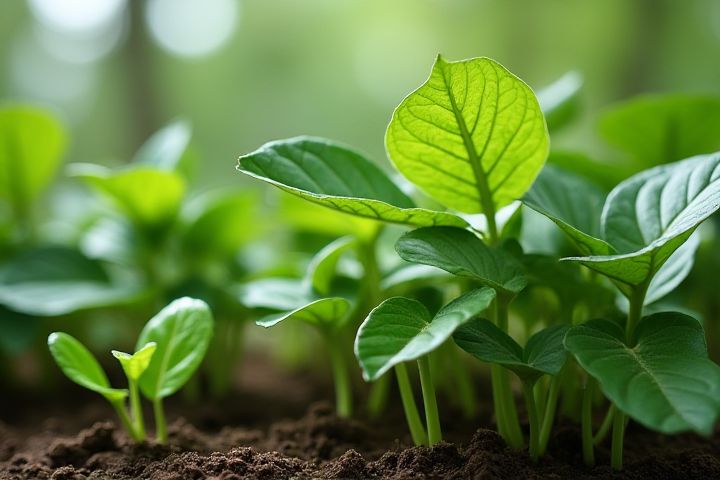
To ensure optimal growth for your houseplants, position them near sources of natural light, such as east or south-facing windows. Consider the specific light needs of each plant; for instance, succulents thrive in bright light, while ferns prefer indirect light. Maintain proper humidity levels by avoiding areas with excessive draft or heat, like near heating vents or air conditioning units. Regularly rotate your plants to promote even growth on all sides, preventing them from leaning towards the light source. Assess your home's temperature, aiming to keep it between 65degF and 75degF for most houseplants to flourish.
Where To Place Houseplants For Best Growth
Light exposure
To maximize your houseplants' growth, place them in areas that receive appropriate light exposure tailored to their specific needs. For instance, plants like succulents and cacti thrive in bright, direct sunlight for at least 6 hours a day, ideally near south-facing windows. In contrast, ferns and pothos prefer indirect light and should be positioned in east or north-facing locations to prevent leaf burn. Regularly monitor your plants, as signs of insufficient light include leggy growth or yellowing leaves, indicating that you may need to adjust their placement.
Humidity levels
For optimal growth, position your houseplants in areas where humidity levels range between 40% to 60%. Bathrooms or kitchens, where moisture levels are naturally higher, can be ideal spots for humidity-loving plants like ferns or peace lilies. You can also use a humidifier to maintain consistent humidity, especially during winter months, when indoor air tends to be drier. Grouping plants together can create a microclimate with increased humidity, benefiting both your plants and overall aesthetic.
Temperature range
Houseplants thrive best in a temperature range of 65degF to 75degF (18degC to 24degC), making placement near windowsills or well-insulated areas ideal. Avoid placing them near drafts, heaters, or air conditioning vents, which can create temperature fluctuations detrimental to growth. If indoor temperatures drop below 60degF (15degC) or exceed 80degF (27degC), many plants may experience stress or stunted growth. Monitor your plant's response to its environment closely, as different species may have unique temperature preferences within this general range.
Air circulation
For optimal air circulation, place your houseplants at least 2 to 3 feet away from walls or larger furniture, allowing airflow to reach all leaf surfaces. Position them near windows where fresh air can flow in, but avoid direct drafts that may stress the plant. Consider using plant stands or shelves to elevate your greenery, providing both aesthetic appeal and improved air movement around the lower leaves. Regularly rotating your plants can also promote even exposure to light and enhance overall growth by ensuring that all parts receive adequate air circulation.
Space availability
For optimal growth, houseplants should be placed in areas with sufficient space and access to natural light. South-facing windows are ideal, allowing for 6 to 8 hours of sunlight daily, but ensure there's enough space to accommodate larger plants without crowding. Consider vertical spaces such as shelves or hanging planters to expand your plant collection without sacrificing floor area. Maintaining a distance of at least 12 inches between plants can promote air circulation and prevent fungal diseases, ensuring healthier growth.
Proximity to windows
Placing houseplants within 2 to 4 feet of a south-facing window typically offers optimal sunlight exposure, promoting healthy growth. For plants that thrive in bright, indirect light, situating them near east or west-facing windows is ideal, as these locations provide softer morning or late afternoon rays. Avoid placing plants too close to drafty windows or areas with fluctuating temperatures, which can stress the plants and hinder their development. Ensure that you rotate your plants every few weeks to promote even growth and prevent them from leaning toward the light source.
Avoidance of drafts
To promote optimal growth for your houseplants, position them away from doorways and windows that frequently open, as drafts can cause stress and hinder development. Establish a stable environment by placing plants in areas where temperatures remain consistent, ideally between 65degF and 75degF (18degC to 24degC). Consider a spot with indirect sunlight to ensure even light exposure, as direct sunlight can lead to leaf burn. Grouping plants together can also create a microclimate that enhances humidity levels, improving overall growth conditions.
Distance from heat sources
Position your houseplants at least 3 to 4 feet away from heat sources like radiators, heaters, and direct sunlit windows to prevent temperature fluctuations. Consistently high temperatures can stress plants, leading to leaf drop or stunted growth. The ideal indoor temperature for most houseplants ranges from 60degF to 75degF, making it essential to maintain a comfortable environment away from direct heat. Consider placing your plants on shelves or tables where airflow can remain steady, ensuring they thrive in a stable climate for optimal growth.
Shelter from pets and children
To ensure optimal growth for your houseplants while safeguarding them from pets and children, consider placing them on elevated surfaces such as bookshelves or window sills. Utilize hanging planters or wall-mounted shelves to create a visually appealing display that is out of reach yet provides ample sunlight. Avoid areas with high foot traffic, as pets and children may inadvertently knock over your plants. Additionally, choose locations near windows that offer filtered light, which can further enhance your plants' health while ensuring their safety.
Complementary plant combinations
Placing houseplants near each other according to complementary plant combinations can significantly enhance their growth and health. For instance, pairing plants like spider plants with peace lilies can create a humid microenvironment that benefits both, as peace lilies thrive in higher moisture levels. Positioning sun-loving plants, such as succulents, alongside indirect light-loving plants, like ferns, ensures that each one receives optimal light without overshadowing its companion. Grouping plants with similar watering needs, like pothos and philodendrons, can also streamline your care routine while promoting a balanced and thriving ecosystem.
